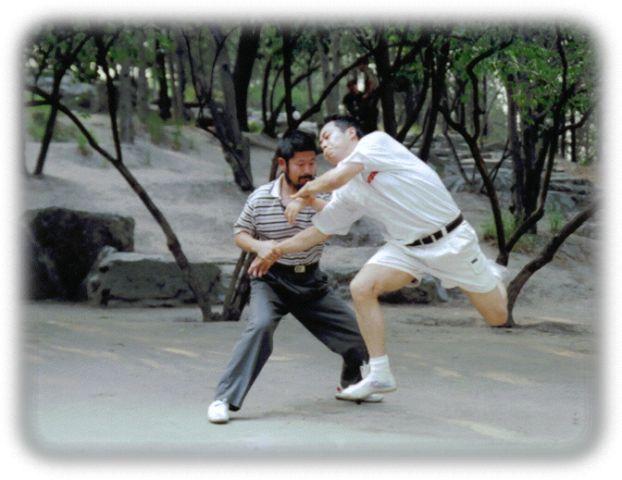
One of the joys of teaching Tai Chi to older adults is that you can see progress as they develop. The people who come into my class for the first time have very little balance or coordination so if they decide to stick with it you can clearly and profoundly see your impact as a teacher.
Knowing the impact of falls on that population and helping some people avoid some of those negative outcomes is quite rewarding.
The major challenges I see in people when they enter my class is not knowing the location of their center. This becomes increasingly evident when they are constantly overreaching, which places a heavy load on the vertebrae, and makes them top heavy. They also do not have their feet flush on the ground, which can again result in a fall. Overall, there is little coordination between the upper and lower half. I am always discussing the importance of the top half and lower half moving in agreement with each other and that discussion leads directly to the person responsible for the popularization of Tai Chi, Yang Cheng Fu. Yang Cheng Fu promoted the health benefits of Tai Chi, and created a list of 10 important points to do Tai Chi correctly (below). An excellent book on his teaching can be purchased here.
Yang Cheng Fu’s 10 important points:
1. Empty Neck, Raise Spirit
2. Contain Chest, Raise Back
3. Loosen Waist
4. Differentiate Empty Full
5. Sink Shoulders, Drop Elbows
6. Use Intention not Exertion
7. Upper Lower Mutually Follow
8. Inner Outer Mutually Harmonize
9. Continue without Interruption
10. Move from Centre, Seek Calm
One of those important points is, "Upper Lower Mutually Follow" where I see most people have difficulty when they are learning Tai Chi. Most older adults I teach think that the Tai Chi form is a series of choreographed dance moves and want to memorize steps and hand positions. I guess being American and older they come to class with their prior experiences from square dancing and other American dance forms they grew up with. What they are missing is their whole structure is a shell with little or any understanding of the internal work that Tai Chi demands.The one exception to this is a woman who was married to a Spanish gentleman and they did a lot of Latin dancing. She had a very well cultivated understanding of her dan tian and could root quite well. Currently, she is 82 years old and still going strong.
I often share with my students Yang Cheng Fu’s important principles because I think they are essential to truly practice Tai Chi. In fact, my teaching of Tai Chi focuses on cultivating these principles rather than rote memorization of the 24 form, because if you can attain some level of proficiency with these principles it will be more beneficial to your health and well-being.
One of the things I continually notice in class as people age is they use their kua less and less, and those who have the most balance issues seem to be the most rigid in their kua (Pictured below). The kua is known anatomically as the inguinal crease or the grove where the femur meets the pelvis. In a quote from Zhang Xue Xin, a renowned Chen-style Tai Chi master, “Americans know how to use the hips and not the kua.” (this quote is from the hyper link to a paper on the kua above)
- Is the "glue" between the upper and lower halves of the body.
- Keeps the center of balance aligned and sunk.
- Provides better alignment of the body for smoother movement with less chance of sprains.
- Creates a "mutable" joint that increases leverage and disperses force by tricking the opponent as to the actual location of your center.
- Increases power output, i.e. force multiplier.
The dan tian is a Chinese term that means “Sea of Qi.” If you read ancient Taoist texts there is a lot of mystical abilities attached to this area. For an essay on that topic click here. Suffice to say, that the dan tian is the center of balance for people, it is located 1”- 2” below the navel and midway between the lower abdomen and the spine. Many people argue about exact locations but this is not meaningful to our purpose here. There is no anatomical distinction for the dan tian. It is however your true center and that is the most important thing to remember. Every object has a center of balance because gravity makes it so.
One of the best explanations on opening the kua is by Chen style practitioner, Chen Zhonghua. He has a trailer for his video that can be purchased here. Unfortunately, I can not find anyone on youtube who explains it as clearly as he does.
Training your body to move from the kua and its relation to the actual physical center of your body (dan tian) is a real game changer for your practice. If you were to go up to the average person on the street and ask them where their center was, they might point to their heart or to their stomach area but I will bet you most will not be close to knowing where it is. Imagine you have this body and every day you are walking around on this earth and you are completely clueless as its proper alignment with its true place in the universe? This awareness changes your life because for years you have walked, played and slept thinking it was way higher than it actually is and once you embody its placement your body is unlocked and you can experience so much more of life.
No comments:
Post a Comment